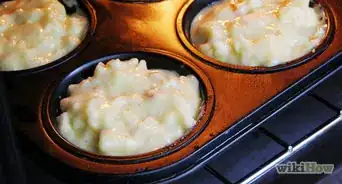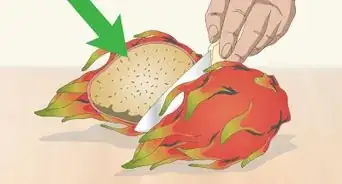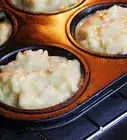wikiHow is a “wiki,” similar to Wikipedia, which means that many of our articles are co-written by multiple authors. To create this article, 20 people, some anonymous, worked to edit and improve it over time.
wikiHow marks an article as reader-approved once it receives enough positive feedback. This article received 23 testimonials and 94% of readers who voted found it helpful, earning it our reader-approved status.
This article has been viewed 499,386 times.
Learn more...
The strange patterns on a cantaloupe may as well be a map of Pluto for many shoppers. Unlock the secrets of this musky fruit and learn how to leave the store with a ripe, sweet bounty.
Steps
Choosing a Cantaloupe
-
1Look for signs of decay. Take a look at the bin, shelf, or box the cantaloupes are being stored in. If there are flies or other insects around it, or there is juice leaking out and covering the fruits, it's probably a good idea to buy your melon elsewhere.
- Avoid melons with punctures, dents, or brown or black patches.
- If there's only one patch of discoloration, this is probably where the melon rested on the ground, or where it was sunburned. This will usually not affect the taste.[1]
-
2Check the rind color and webbing. A ripe cantaloupe has a yellow, tan, or cream-colored rind. This is covered with a webbed pattern, which has some areas that are more pronounced and raised off the surface. A grey-green rind covered by a flat web means the cantaloupe is unripe.[2]
- Some newer varieties may stay green even when ripe.[3] If every cantaloupe in the pile is green, try looking up the variety name online or asking a store employee.
Advertisement -
3Examine the stem end carefully. Never buy a cantaloupe with a rough or torn end, a lumpy end protruding from the fruit, or one that has nubs of stem still attached. These were picked too early, and will have poor flavor. Instead, look for a melon with a smooth, round "belly button" depression at one end instead.
- Although you can feel this end for the slight give that indicates ripeness, this is an unreliable test and can cause bruising. Do avoid melons with a wet, leaking end.
-
4Heft and tap the cantaloupe. The melon should be heavy for its size. It should be firm, but not rock hard. Tap it and listen for a low, solid sound. A high, hollow sound is a bad sign.[4]
- Stay alert for signs of an overripe melon: a sticky surface, damp patches or bruises, or a sloshing sound when moved.[5]
-
5Feel and smell the blossom end. A little give at the blossom end (opposite the stem end) is ideal. More importantly, it should have a pleasant, sweet smell, akin to flowers. An overpowering sweetness may mean the fruit is overripe and fermented.
- The smell of alcohol or acetone (nail polish remover) means the melon is very fermented.
- To avoid getting a melon with a mushy interior, press it gently all over. Is it firm? If you feel any soft spots or dimples, it will be mushy.
Storing and Handling Cantaloupe
-
1Store cantaloupe in the refrigerator. The cold temperature will reduce the chance of bacterial growth, and keep the melon crisp. Keep the melon between 36 and 40ºF (2.2–5ºC) for best results.[6] (Most likely, the crisper drawer of your refrigerator already falls in this range.)
- You may store an unripe melon for a couple days at room temperature. Once ripe, refrigeration is highly recommended for health reasons.
- The strong smell can cling to other items in the refrigerator. Store the melon in a closed glass or plastic container to prevent this.
-
2Wash hands when handling cantaloupe. There have been several outbreaks of Salmonella and other bacteria from cantaloupes, partly because consumers are not aware they should be cautious.[7] Wash your hands with soapy water after transporting your cantaloupe home. Wash your hands again before and after cutting the melon.
-
3Scrub the melon before cutting. The melon rind often contains bacteria that may be pushed onto the fruit by the knife. The webbed pattern can make it difficult to wash off the bacteria, so rub it thoroughly with a clean brush or your fingers instead. Hold the melon under running water as you do this.[8] Pat it dry with paper towels when finished.
- Do not wash the melon in advance. Even a little moisture and softened rind can lead to mold growth.
- Do not use soap, which the melon can absorb through the rind.
-
4Cut the melon. Use a clean knife and cutting board. Cut in half from the blossom end to the stem end, scrape out the seeds, then cut into slices.[9] Wash all knives and surfaces once you're done enjoying the cantaloupe.
-
5Peel and store leftovers. Do not leave cut cantaloupe out for more than four hours; some guidelines recommend no more than two.[10] [11] Cut the flesh away from the peel and store covered in the refrigerator.[12]
- Alternatively, freeze cantaloupe flesh in between layers of wax paper. For best flavor, serve within one month, partially thawed. To preserve flavor and color longer, cover in sugar or sugar syrup before freezing.[13]
Community Q&A
-
QuestionMy grandmother always said to shake it and listen for loose seeds to tell when it's ripe. Is this true?
 Community AnswerHave you tried it? It may be true; I test cantaloupe by smelling the bottom of the melon. If it smells like melon, it's ripe.
Community AnswerHave you tried it? It may be true; I test cantaloupe by smelling the bottom of the melon. If it smells like melon, it's ripe. -
QuestionWill cantaloupe continue to ripen if it is left out of the refrigerator?
 Community AnswerIf the cantaloupe has not yet been cut, it will continue to ripen if left unrefrigerated. However, if your cantaloupe is cut and left out, it has a higher chance of mold growth and overripeness.
Community AnswerIf the cantaloupe has not yet been cut, it will continue to ripen if left unrefrigerated. However, if your cantaloupe is cut and left out, it has a higher chance of mold growth and overripeness. -
QuestionCan you eat the cantaloupe if it has an alcohol taste?
 Community AnswerThe smell of alcohol in fruit means the melon is fermented, which may be bad for you (depending on the type of fruit and how long it has been fermenting).
Community AnswerThe smell of alcohol in fruit means the melon is fermented, which may be bad for you (depending on the type of fruit and how long it has been fermenting).
Warnings
- Shaking the cantaloupe to listen for rattling seeds is not an accurate test. People can't even agree whether the rattle is good or bad! There might be some varieties of cantaloupe that rattle when they're ready, but most fruit sold will remain silent in any state.[15]⧼thumbs_response⧽
References
- ↑ http://anrcatalog.ucdavis.edu/pdf/8095.pdf
- ↑ http://bonnieplants.com/growing/growing-cantaloupe-and-honeydew-melons/
- ↑ http://anrcatalog.ucdavis.edu/pdf/8095.pdf
- ↑ http://www.whfoods.com/genpage.php/genpage.php?tname=foodspice&dbid=17
- ↑ https://books.google.com/books?id=Mt7KAgAAQBAJ&dq
- ↑ http://www.fda.gov/downloads/Food/GuidanceRegulation/UCM168625.pdf
- ↑ http://www.fda.gov/downloads/Food/GuidanceRegulation/UCM168625.pdf
- ↑ http://anrcatalog.ucdavis.edu/pdf/8095.pdf
- ↑ http://anrcatalog.ucdavis.edu/pdf/8095.pdf
- ↑ http://www.fda.gov/downloads/Food/GuidanceRegulation/UCM168625.pdf
- ↑ http://www.whfoods.com/genpage.php/genpage.php?tname=foodspice&dbid=17
- ↑ http://anrcatalog.ucdavis.edu/pdf/8095.pdf
- ↑ http://anrcatalog.ucdavis.edu/pdf/8095.pdf
- ↑ http://anrcatalog.ucdavis.edu/pdf/8095.pdf
- ↑ https://www.baltimoresun.com/news/bs-xpm-2001-07-25-0107240322-story.html
About This Article
If you’re buying a cantaloupe, start by picking it up to see if it’s firm and heavy for its size, which it should be. Give the cantaloupe a tap and listen for a low, solid sound, which is a good sign. Look for a cantaloupe with a yellow, tan, or cream-colored rind that has a raised, webbed surface, which indicates ripeness. You can also smell the end of the cantaloupe opposite the stem. If it smells pleasant and sweet, a little bit like flowers, then it’s probably ripe and ready to be eaten. For tips on cutting and storing cantaloupe, keep reading!

































































